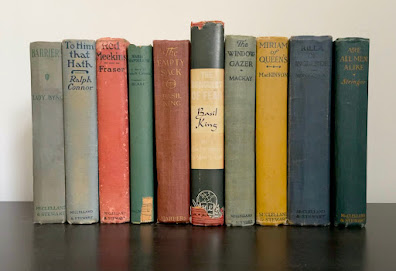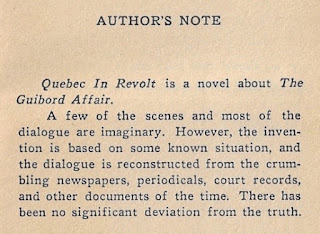No surprise, I suppose.
Doubt it.
I purchased Quest for Pajaro after having been invited to comment on Allan's work at this year's Toronto Jewish Film Festival. While not his best book, it is his most intriguing. There hadn't been many many Canadian science fiction romances before 1957 – still aren't. What's more, the novel's linchpin is an experimental jet known as the "Arrow."
Bruce Petty's gorgeous jacket illustration puts it over the top.
What follows is the rest of the ten best:
Horace Brown
Pickering, ON: Global
Horace Brown's adaptation of this film noir shot in Quebec City, for years I'd hoped to find a reasonably-priced copy. This year I did (US$89.95).
E. Louise Cushing
New York: Arcadia, 1956
A mystery novel that begins with the discovery of a body in a Montreal bookstore, since I'd long been searching for this novel. Might it be a candidate for reissue as a Ricochet Book?
Nope.
Still, I'm still happy to have it in my collection.
Basil King
Claire Martin
I've admired Claire Martin since reading Dans un gant de fer in CEGEP. David Lobdell's translation of her Doux-Amer deserves a return to print. Imagine the thrill in finding three signed Martins during my recent visit to Quebec City. This is one.
Christopher Plummer
Toronto: Random House,
I'm slowly been buying them back. This signed copy was found at the Kemptville Youth Centre Book Fair.
Toronto: Standard
I own many copies of Beautiful Joe, but this is by far the most... um, beautiful. At one dollar, it was the least expensive book I purchased this year.
The Countess of Aberdeen provides an introduction!
Ottawa: Éditions Fides, 1967
Another Quebec City find, I came upon this inscribed, slip-cased edition on the very same day I made my pilgrimage to the author's home.
I vow to read it in the New Year.
Garnett Weston
New York: Messner, 1944
This old novel proved to be 2021's most unpleasant, stomach-turning read. Voyeurism, adultery, greed, murder, and something approaching necrophilia figure.
Good fun from a Toronto boy who made a killing in Hollywood before retiring to Vancouver island.
Lee Goldberg noted my interest in the novels of former Vancouver newspaperman Tom Ardies (Their Man in the White House, Kosygan is Coming) and was kind enough to send me newly published copies of This Briefcase is Going to Explode, Pandemic, Balboa Firefly, and Manila Time (the latter two written under Ardies' Jack Trolley nom de plume).
Lee is in the process of reissuing Ardies' entire bibliography through Brash Books.
More power to him!
Fraser Sutherland died this earlier this year. I was honoured to have been asked to provide an obituary for the Globe & Mail. One of the greatest challenges in its writing concerned family, specifically the name of a sibling, an older brother, who had died at a young age. Our newspaper of record is insistent on such things. It seemed not one of Fraser's friends could quite remember... and then one came through, which led me to this uncommon chapbook:
RIP, Fraser. You are much missed.

















































